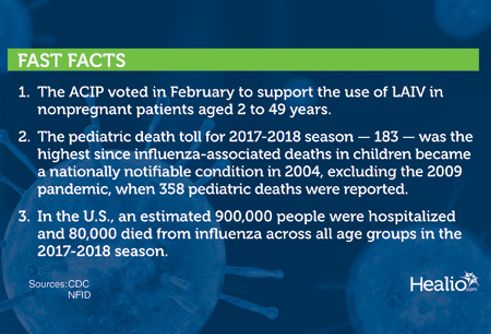AAP, ACIP’s previous FluMist recommendations supported by 2013-2016 data
Concerns about the effectiveness of the quadivalent, live-attenuated influenza vaccine, or LAIV4, prompted both the AAP and the Advisory Committee on Immunization Practices to recommend against its use during the 2016-2017 and 2017-2018 influenza seasons. New findings published in Pediatrics appear to support those recommendations.
In February 2018, the ACIP once again recommended LAIV4 — marketed as FluMist (AstraZeneca) — for use in patients aged 2 to 49 years after the manufacturer modified the vaccine and presented evidence that it protected more effectively against influenza A(H1N1)pdm09. The AAP, however, continues to advise against the use of LAIV4 but suggests it could be used in children who would not otherwise be vaccinated. The vaccine is administered intranasally, making it a more attractive option for parents and pediatric patients than an injection.
Jessie R. Chung, MPH, an epidemiologist in the CDC’s Influenza Division, and colleagues analyzed pooled data from five studies conducted between the 2013-2014 and 2015-2016 influenza seasons. These studies examined the efficacy of LAIV4 and inactivated influenza vaccine (IIV) in children and adolescents aged 2 to 17 years.
The researchers identified 17,173 pediatric and adolescent patients with influenza during the study period. Of these patients, 4,579 were administered IIV and 1,979 were administered LAIV4.
According to Chung and colleagues, vaccine effectiveness against A(H1N1)pdm09 was 67% (95% CI, 62%-72%) for IIV and only 20% (95% CI, –6% to 39%) for LAIV4. Children who received LAIV4 were more than two times as likely to be infected with influenza A(H1N1)pdm09 compared with children who received IIV (OR = 2.66; 95% CI, 2.06-3.44).
“Additional efforts have been taken by the manufacturer to identify the cause of the reduced effectiveness of influenza A/H1N1pdm09 LAIV strains,” Chung and colleagues wrote. “The LAIV H1N1 vaccine virus for the 2017-2018 and 2018-2019 influenza seasons — A/Slovenia/2309/2015 — has demonstrated improved replicative fitness in the laboratory and increased shedding and serum antibody responses among children compared with A/Bolivia/559/2013” — the strain that was previously used in the vaccine. – by Katherine Bortz
Disclosures: Chung reports no relevant financial disclosures. Please see the study for all other authors’ relevant financial disclosures.


